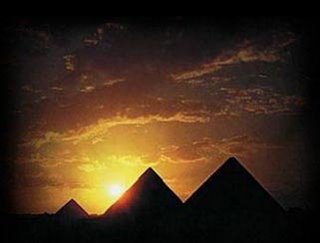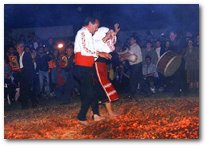
The pyramids of Egypt, among the largest constructions ever built by man, constitute one of the most potent and enduring symbols of Ancient Egyptian civilization. It is generally accepted by most archaeologists that they were constructed as burial monuments associated with royal solar and stellar cults, and most were built during the Old and Middle Kingdom periods from 2575 B.C. to 1648 B.C.
The Great Pyramid of Cholula, the world's largest monument and largest Pre-Columbian pyramid by volume, is a huge complex located in Cholula,  Puebla, Mexico.
Puebla, Mexico.
Only a fraction of a staircase on one side of the Great Pyramid of Cholula has been restored to its former glory.
The temple-pyramid complex was built over many generations, from the 2nd century BC to the early 16th century, and was dedicated to the deity Quetzalcoatl. It has a base of 450 by 450 m (1476x1476 ft) and a height of 66 m (217 ft). According to the Guinness Book of Records, it is in fact the largest pyramid as well as the largest monument ever constructed anywhere in the world, with a total volume estimated at 4.45 million m³, almost one third larger than that of the Great Pyramid of Giza in Egypt. (The Giza pyramid is higher, however.) The Aztecs believed that Xelhua built the Great Pyramid of Cholula.
A ziggurat (Babylonian ziqqurrat, D-Stem of zaqāru "to build on a raised area") is a temple tower of the ancient Mesopotamian valley and Iran, having the form of a terraced pyramid of successively receding stories. Ziggurats were a form of temple tower common to the Sumerians, Babylonians and Assyrians of ancient Mesopotamia. The earliest examples of the ziggurat were simple raised platforms that date from the Ubaid period during the fourth millennium BCE and the latest date from the 6th century BCE. The step pyramid style began near the end of the Early Dynastic Period. Built in receding tiers upon a rectangular, oval, or square platform, the ziggurat was a pyramidal structure. Sun-baked bricks made up the core of the ziggurat with facings of fired bricks on the outside. The facings were often glazed in different colors and may have had astrological significance. The number of tiers ranged from two to seven, with a shrine or temple at the summit. Access to the shrine was provided by a series of ramps on one side of the ziggurat or by a spiral ramp from base to summit. Notable examples of this structure include the Great Ziggurat of Ur and Khorsabad in Mesopotamia.
The earliest examples of the ziggurat were simple raised platforms that date from the Ubaid period during the fourth millennium BCE and the latest date from the 6th century BCE. The step pyramid style began near the end of the Early Dynastic Period. Built in receding tiers upon a rectangular, oval, or square platform, the ziggurat was a pyramidal structure. Sun-baked bricks made up the core of the ziggurat with facings of fired bricks on the outside. The facings were often glazed in different colors and may have had astrological significance. The number of tiers ranged from two to seven, with a shrine or temple at the summit. Access to the shrine was provided by a series of ramps on one side of the ziggurat or by a spiral ramp from base to summit. Notable examples of this structure include the Great Ziggurat of Ur and Khorsabad in Mesopotamia.
The Mesopotamian ziggurats were not places for public worship or ceremonies. They were believed to be dwelling places for the gods. Through the ziggurat the gods could be close to mankind and each city had its own patron god. Only priests were permitted on the ziggurat or in the rooms at its base and it was their responsibility to care for the gods and attend to their needs. As a result the priests were very powerful members of Sumerian society.
Saturday, September 16, 2006
Pyramids
Monday, September 11, 2006
Fire Walking in different parts of the World.
Fire-walking is the act of walking barefoot over a bed of hot coals.
Fire-walking is practiced
- by fakirs and similar persons,

- by Eastern Orthodox Christians in parts of and Bulgaria during some popular religious feasts (see nestinarstvo).
- !Kung Bushmen of the African Kalahari desert have firewalked since their tribal beginnings. The !Kung use fire in their powerful healing ceremonies.
- by Japanese Taoists and Buddhists
- as a rite of purification, healing, initiation and transcendence, which have been threads in the cultural tapestry of our planet.
Organizers of firewalking ceremonies sometimes claim that in order to prevent one's feet from burning, meditation, calling on spirits/gods or other supernatural intervention is necessary.
The oldest recorded firewalk occurred over 4,000 years ago in India. Two Brahmin priests were competing to see who could walk farther over hot coals. The victor's triumph was recorded in writing surviving to this day. In a 17th century letter, Father Le Jeune, a Jesuit priest, wrote to his superior, telling of a healing firewalk he witnessed among the North American Indians. He reports of a sick woman walking through two or three hundred fires with bare legs and feet, not only without burning, but all the while commenting on that she could feel no uncomfortable heat. Some 30 years later, Father Marquette reported similar firewalks among the Ottawa Indians and Jonathan Carver writes in his 1802 book, Travels in North America that one of the most astounding sights he saw was the parade of warriors who would "walk naked through a fire...with apparent immunity."
The Science behind FireWalking
David Willey is a physics instructor and an expert on the science of fire walking  at the University of Pittsburgh in Pennsylvania. He said people are able to walk across a bed of burning coals because "wood is a lousy conductor."
at the University of Pittsburgh in Pennsylvania. He said people are able to walk across a bed of burning coals because "wood is a lousy conductor."
"There're three ways heat can get transmitted: conduction, convection, and radiation," he said.
Conduction is the transfer of heat from one substance to another via direct contact. In convection heat is transferred through air or fluid circulation. In radiation it is transmitted as if spreading out in straight lines from a central source (think of the sun or a heat lamp).
Conduction is the main way heat is transmitted to a person's feet during a fire walk.
In fire walking, a person's feet, which Willey said are also poor conductors, touch ash-covered coals.
Since the fire walker is indeed walking, the time of contact between feet and coals is minimal—too quick for the coals to burn or char the feet, Willey said.



